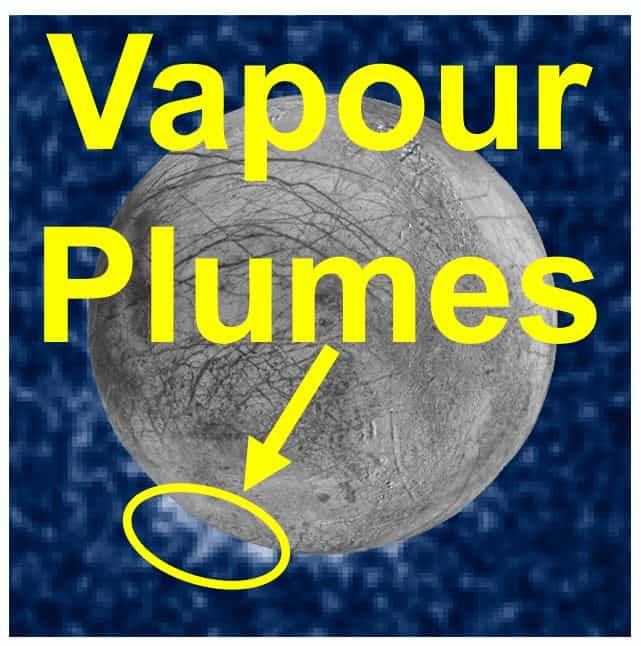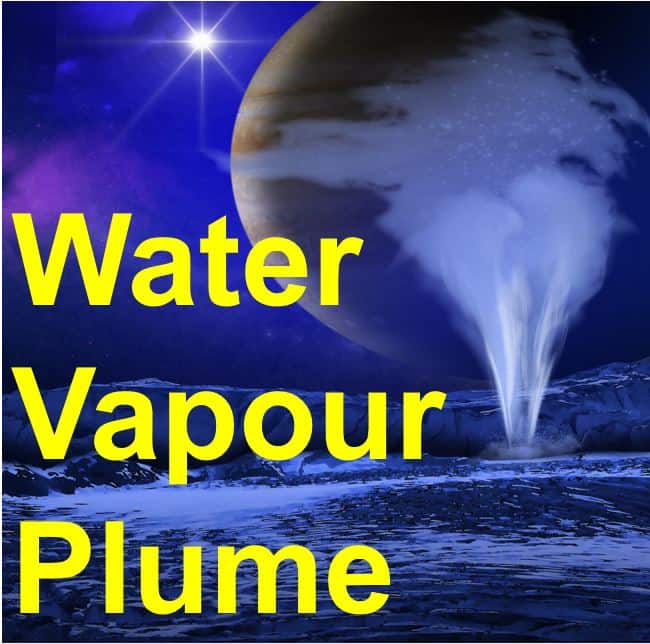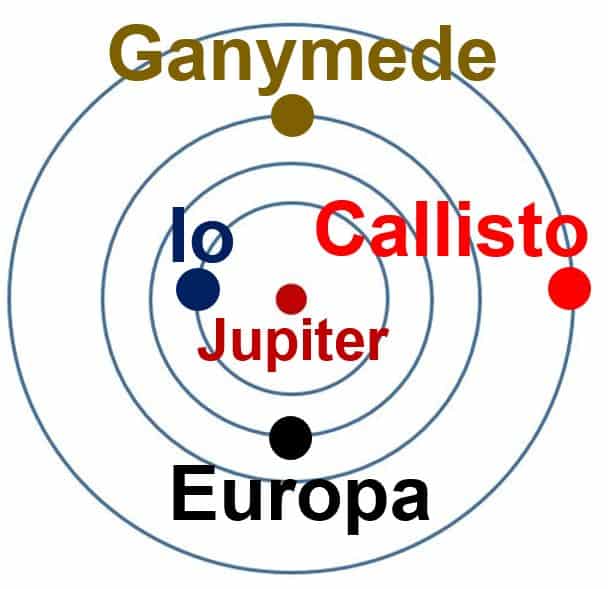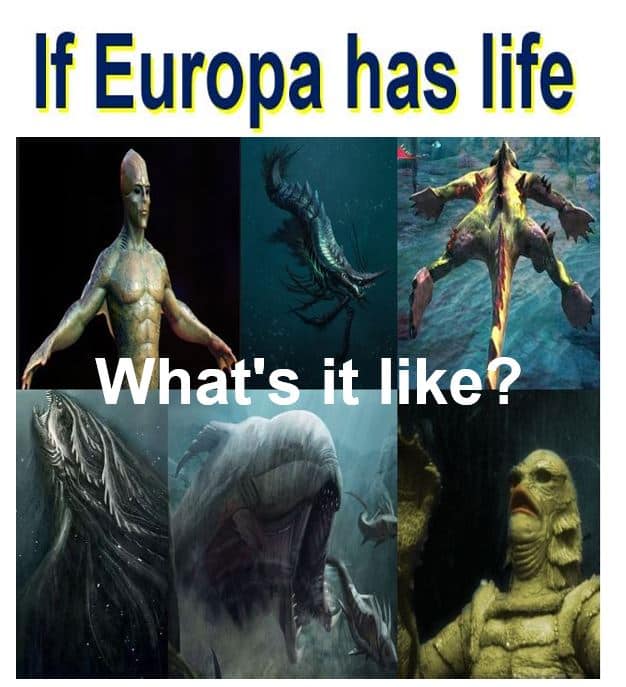Europa, one of Jupiter’s moons, has water vapour plumes erupting from its surface, according to images captured by the Hubble Space Telescope, NASA informed today. This latest finding confirms previous Hubble observations that suggested the icy moon erupted with high altitude water vapour plumes.
A plume is something, such as water, steam (vapour) or smoke that rises into the air in a tall, thin shape.
If there are plumes of water vapour erupting from Europa’s surface, it means that missions to that moon may be able to sample them rather than having to drill through miles of ice to find out what the liquid ocean is made of.
 In this composite image, scientists believe we can see water vapour plumes (within the yellow circle) erupting from Europa’s surface and spewing into space. They were seen in silhouette as Europa passed in front of Jupiter. (Image: nasa.gov)
In this composite image, scientists believe we can see water vapour plumes (within the yellow circle) erupting from Europa’s surface and spewing into space. They were seen in silhouette as Europa passed in front of Jupiter. (Image: nasa.gov)
Vapour plumes could be sampled
Scientists say that under extremely thick ice, Europa has vast oceans of salty, liquid water – more than twice as much as we have in Earth’s oceans. If some of that water is being spewed in jets into the atmosphere, NASA’s space probe or moon robot could sample that water rather than having to get below the surface ice.
For there to be life as we know it on another planet, there needs to be sunlight, oxygen and liquid water. Europa’s ocean has those three requirements for life to exist. Most of its thin atmosphere consists of oxygen.
Geoff Yoder, acting associate administrator for NASA’s Science Mission Directorate in Washington, said:
“Europa’s ocean is considered to be one of the most promising places that could potentially harbor life in the solar system. These plumes, if they do indeed exist, may provide another way to sample Europa’s subsurface.”
NASA scientists estimate that the plumes rise to approximately 125 miles (200 km) before raining back down onto the moon’s surface.
William Sparks, who works at the Space Telescope Science Institute (STScl) in Baltimore, and colleagues observed these plumes – finger-like projections – while viewing Europa’s limb as the moon passed in front of Jupiter.
.@NASA_Hubble has spotted possible water plumes on #Jupiter‘s moon #Europa. Live teleconference ongoing now: https://t.co/be3HhLXtbx pic.twitter.com/XfwsopNlW8
— NASA Solar System (@NASASolarSystem) September 26, 2016
Dr. Sparks and colleagues have written a paper on their work – it will be published in the Astrophysical Journal, September 29th issue.
Dr. Sparks said his team’s original goal was to determine whether Europa had a thin, extended atmosphere, or exosphere (the outermost region of a planet’s atmosphere).
Using the same observing method that astronomers use to detect atmospheres around planets that orbit stars, they realized that if there was water vapor spewing from Europa’s surface, this observation method would be ideal to spot it.
Dr. Sparks explained:
“The atmosphere of an extrasolar planet blocks some of the starlight that is behind it. If there is a thin atmosphere around Europa, it has the potential to block some of the light of Jupiter, and we could see it as a silhouette. And so we were looking for absorption features around the limb of Europa as it transited the smooth face of Jupiter.”
 An artist’s impression of a water vapor plume erupting from the frigid, icy surface of Europa, one of Jupiter’s moons. (Image: nasa.gov. Credits: NASA/ESA/K. Retherford/SWRI)
An artist’s impression of a water vapor plume erupting from the frigid, icy surface of Europa, one of Jupiter’s moons. (Image: nasa.gov. Credits: NASA/ESA/K. Retherford/SWRI)
The team observed Europa passing in front of Jupiter on ten separate occasions over a period of 15 months.
Four years ago, Dr. Lorenz Roth of the Southwest Research Institute in San Antonio, Texas, and colleagues detected evidence of water vapour coming from the surface in the frigid south polar region of Europa, and reaching over 100 miles (160 km) into space. This latest work provides supporting evidence for vapour plumes on Europa.
Both teams used the Hubble Space Telescope Imaging Spectrograph Instrument, but their methods to arrive at the same conclusion were quite different.
Dr. Sparks said:
“When we calculate in a completely different way the amount of material that would be needed to create these absorption features, it’s pretty similar to what Roth and his team found. The estimates for the mass are similar, the estimates for the height of the plumes are similar. The latitude of two of the plume candidates we see corresponds to their earlier work.”
 There are sixty-seven moons that orbit Jupiter. The four largest – The Galilean Moons – are Callisto, Io, Europa and Ganymede. This image is not to scale (Jupiter is far bigger than any of its moons).
There are sixty-seven moons that orbit Jupiter. The four largest – The Galilean Moons – are Callisto, Io, Europa and Ganymede. This image is not to scale (Jupiter is far bigger than any of its moons).
But so far, the two teams have not simultaneously detected vapour plumes using their different techniques. According to what they have observed so far, these plumes may be highly variable – they may erupt sporadically for some time, die down, with quiet periods elapsing before other eruptions occur.
When these findings are confirmed, we will know for certain that Europa is the second moon in our Solar System to have water vapour plumes. Saturn’s moon – Enceladus – has them, according to observations made by NASA’s Cassini orbiter in 2005.
 If Europa does have life, what’s it like? Any life form would need to be aquatic – adapted for surviving under water. Would there be any intelligent life? If so, and they travel through space, are their spaceships filled with water?
If Europa does have life, what’s it like? Any life form would need to be aquatic – adapted for surviving under water. Would there be any intelligent life? If so, and they travel through space, are their spaceships filled with water?
After NASA’s James Webb Space Telescope is launched in 2018, scientists may be able to use its infrared vision to confirm venting or plume activity on Europa.
NASA says it is currently formulating a mission to Europa which would carry instruments that could confirm the presence of plumes, as well as study them from close range during multiple flybys.
Paul Hertz, Director of the Astrophysics Division at NASA Headquarters in Washington, said:
“Hubble’s unique capabilities enabled it to capture these plumes, once again demonstrating Hubble’s ability to make observations it was never designed to make. This observation opens up a world of possibilities, and we look forward to future missions — such as the James Webb Space Telescope — to follow up on this exciting discovery.”
Video – Vapour Plumes detected on Europa
This NASA Goddard video explains that the Hubble Space Telescope has imaged what scientists believe are water vapour plumes erupting from Europa’s icy surface.
